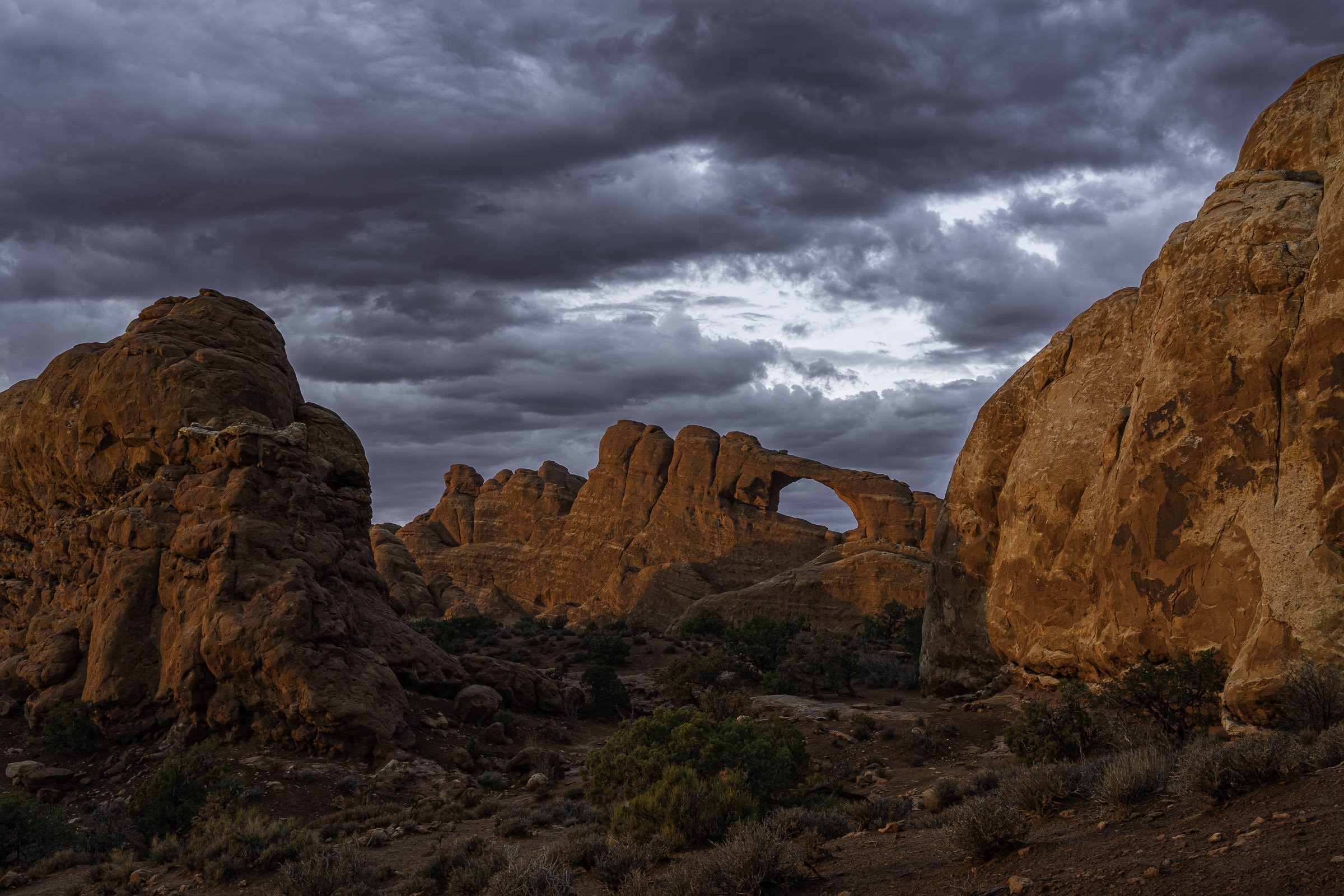Professional landscape and adventure photographer Bret Edge shares a landscape photography tip he learned in an Arizona Highways guidebook over twenty years ago that he continues to apply today.
Read moreA Retrospective on Iconography
Delicate Arch Reflecting in Pothole at Sunset, Arches National Park
I haven’t heard the term “iconography” in a couple of years, but in the past it was used to describe, in a somewhat derogatory or condescending manner, the practice of seeking out and photographing the icons of landscape photography: Delicate Arch, Snake River Overlook, Zabriskie Point, etc. Used in a sentence, it would be something like this: (Look down nose and speak in an intentionally nasally voice) “Ugh. Can you believe these people sharing photos of Delicate Arch? Don’t they know that there is nothing new to photograph there? Iconography is just sooo lame.”
Many years ago I wrote an article for the Nature Photographer’s Network website titled “Iconography: A Fresh Perspective”. It was, essentially, written in defense of those who, like myself, enjoy photographing well known, iconic locations. NPN was and still is the premier website for nature photographers to connect and share their work in a friendly, supportive online environment. In the article, which you will find below, I shared tips on how to create unique images at even the most iconic locations. I still believe that photographing iconic locations can be a powerful learning experience for new photographers and a valid creative exercise for seasoned ones. However, given the overcrowding issues at many of these locations and the unfortunate and sickening incidents of vandalism that are becoming more common, I’ve got mixed emotions about promoting iconography.
That original article was written ten or more years ago. Re-reading it today, the content is just as relevant but I believe there are new considerations to be made in light of the increased visitation and changing visitor demographic. Many of these can be summed up with one simple sentence: Don’t be an asshole. Seriously. I’ve heard photographers scream at families to “get out of the way!” while they’re briefly standing under Delicate Arch for a keepsake photo of their one and only visit to Arches National Park. At Mesa Arch I’ve seen photographers jostle others out of the way, or move a neighboring photographer’s tripod without permission. We’ve all heard of the truly enormous assholes vandalizing rock art and ruins (read my thoughts on this here), stealing the mysterious moving rocks at Death Valley’s Racetrack playa, toppling hoodoos in Goblin Valley…the list goes on and on. Here’s my advice: just don’t. Just don’t be that guy or gal. Be considerate of others. Expect large crowds at most iconic locations and understand that every one of those other folks have as much right to be there as you do. Your big expensive camera doesn’t give you any special privileges not held by all those other tourists. Figure out how to work around the crowds. Don’t climb inside ruins so you can build a fire for more “natural light” in your starry sky photo. Think, “Would my mama approve of my behavior or would I be getting an ass whoopin’ right now?”
Don’t like crowds? Consider an off-season visit, or if a location is normally photographed at sunrise, check it out at sunset. Try to find an alternative location from which to photograph. I’ve shot Delicate Arch at sunrise and Snake River Overlook at sunset, the opposite of what is typically recommended at both and you know what? There were fewer people and I made quality images at both locations. Consider it a challenge to your creativity. Or, if you just can’t play nice at the icons, don’t go. There’s no shortage of truly breathtaking scenery that you can have entirely to yourself.
We photographers shoulder much of the blame for the overcrowding we’re seeing now. We produce gorgeous photos and share them online, where they are viewed by Clark Griswold in Illinois, who decides that this summer he and the family are hoppin’ in the Wagon Queen Family Truckster and driving across the country to see the Grand Canyon for themselves…multiplied by thousands. Given that it’s partially our fault the icons are so busy, shouldn’t we visit them with a measure of grace and humility?
Original NPN Article
The 1.5 mile trail to Delicate Arch, in Arches National Park, is a rite of passage for many nature photographers. We heft our heavy packs and start out across the gentle sandy path, cross the footbridge and are soon standing atop a short series of switchbacks. Squinting into the western sky, we have a raven’s eye view of the small parking lot full of vehicles and buzzing with activity. Continuing up the trail we ascend a wide swath of steep sandstone, using small cairns to guide us to the top of the otherwise near featureless rock. Not long after summitting the big slab of red rock, we walk along a trail literally carved into a wall of sandstone with a precipitous drop to our left. We round a bend and without warning, Delicate Arch makes a grand entrance right smack in front of our disbelieving eyes. Through its massive span are the snowcapped La Sal Mountains, whose prominent peaks contrast sharply against a brilliant blue sky. The scene before us is quite literally postcard perfect. As our initial awe fades, our eyes stray from the beauty of the scene before us to the chorus line of photographers lining the narrow strip of sandstone at our feet. It appears as though every inch of this small parcel of real estate has already been claimed by photographers and tourists who have all come for the same reason; to watch Delicate Arch awash in fiery hues during the final few minutes of the day. So much for solitude!
Chances are this scenario is precisely what comes to mind when you think of Delicate Arch. There are tripod legs crossing tripod legs, random banter about photography gear and, during the last few minutes of golden light, the cacophony of a dozen shutters whirring in unison. Wouldn’t it be nice to have the arch all to yourself and go home with a unique photograph of one of the most popular destinations in any National Park? Well, you can. Keep reading and I’ll tell you how.
Icons have reached “icon” status for good reason. They are jaw dropping, heart thumping, grab you by the throat and slap you around gorgeous. In most cases they have become natural ambassadors, welcoming the throngs of tourists who infuse the local economies with a steady cash flow. Therein lays the “problem”. All those tourists have come to see with their own eyes the icon they have seen in countless magazines and postcards. They all hike the same 1.5 mile trail and take a seat on the sandstone next to their fellow tourists, some of whom have come armed with tripods and cameras. Ninety nine percent of them return home with the standard “La Sal Mountains framed by Delicate Arch” photo that has graced many a postcard. They are oblivious to the fact that maybe, just maybe, there is a unique composition just around the corner, or down in the sandy bowl or across the way on that imposing bluff. Along with that unique composition often comes something that so many photographers rightfully seek: solitude!
I’ve learned that there are two simple rules to finding a new angle of an icon in peace and quiet, away from the crush of the crowds.
1) Visit in the off-season
Most iconic locations have an “off-season”, or a time when visitation shrinks to a mere fraction of the hustle and bustle experienced during the prime time. During the winter months you will most likely find yourself among only a few other hikers who have come to watch sunset at Delicate Arch. On my last visit, in January, a whopping five people had gathered for the day’s curtain call. During spring and fall, it is not uncommon for over 100 hikers to be in attendance here.
The off-season also has other wonderful benefits. Hotels in Moab can be had for $50/night…including breakfast! The Arches campground is nearly a ghost town during the winter, offering solitude and a place to pitch your tent that you won’t find in the summer.
2) Scout it out!
Whether you choose to visit during prime time or the off-season, scouting the area can and usually will reveal a number of unique compositions away from the crowds. Arrive at the trailhead a few hours early and use the extra time to explore the area around the icon. At Delicate Arch, there are a number of wonderful photographs to be had from inside the large bowl just below the arch. Or, scramble up to the bluff behind the arch for uncommon views of its backside which, in winter, receives most of the warm sunset light.
If you are pressed for time or simply too lazy to explore, bring along a model. Including a person in your photo can lend scale to the scene and create a very different perspective, even if the overall composition is a fairly common one.
Whether photographing an icon or an unknown spectacle of nature, photographers take pride in creating images that move the viewer. But, there is a certain degree of satisfaction that comes from putting your own individual twist on an iconic scene and coming away with an extraordinary photo.
I have been told that there isn’t a single scene at Delicate Arch that hasn’t already been photographed. I have no doubt that many would say the same about the Maroon Bells in fall, Death Valley’s Zabriskie Point or the mighty Tetons from Schwabacher Landing. I only hope that those who hold such a narrow-minded view won’t discourage others from experiencing the fulfillment that comes from challenge of discovering a new perspective on an old favorite. To me, that is what iconography is all about.
A Beginner's Guide to Outdoor Photography: Choosing The Right Gear
Sunrise on the Teton Range from Hedrick Pond Overlook, Grand Teton National Park
Moab, Utah based professional nature and adventure photographer Bret Edge shares tips on choosing the right cameras and gear to get started on the right path in outdoor photography.
Read more


